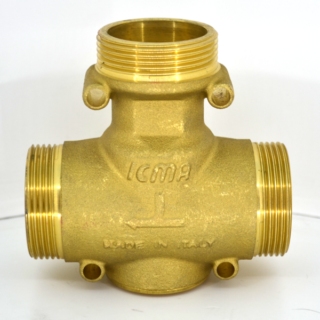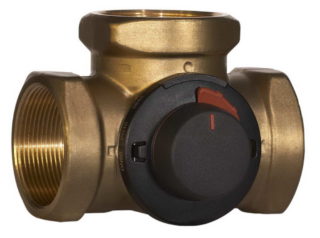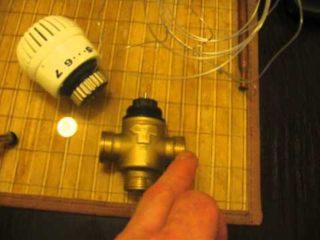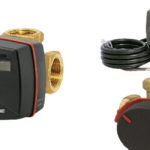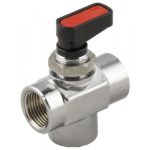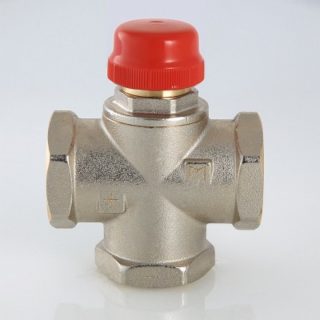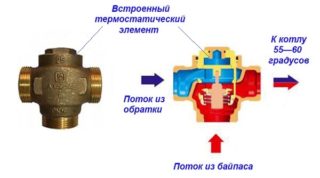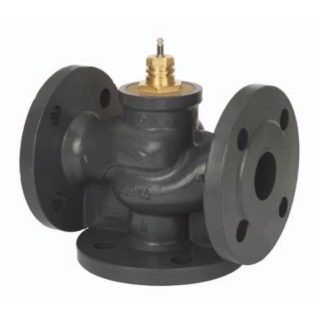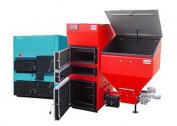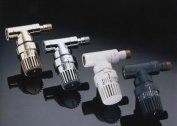The mixing unit belongs to the category of pipeline control valves. A three-way valve for heating mixes different flows of the coolant into one to obtain a stable temperature. The node divides and switches the flows to other highways with the appropriate installation scheme. The valve operates automatically when there is a drive and the signals from the monitoring sensors are received.
The device and features of the three-way valve
The module is used in the liquid heating system and as part of the piping of air heaters and air coolers. Three-way regulators are divided into separation and mixing types.
Valves are similar in design and consist of parts:
- housing;
- connecting flange;
- sealing element;
- link for transmitting force from the drive to the shutter;
- a plunger of various profiles to determine the type of adjustment;
- seat for fitting the plunger in a closed position.
The regulating element is the running rod or the rotary ball. These mechanical links do not completely shut off the valve, leaving room for mixing or redistribution of currents.
Types of Management Method
The types of control depend on the working conditions and purpose. Locking sensors of the heat main transmit commands to the controllers, and they coordinate the actions of energy suppliers.
There are types of drives:
- with a temperature regulator;
- electric drive;
- pneumatic;
- hydraulic.
A drive with manual adjustment is much less common.
Hand operated
The stem is driven by a rotary handle or valve. For convenience, a control panel is installed on which marks are made. Risks correspond to certain thermal hydraulic modes.
- The positive points include:
- low cost of manual drive;
- direct monitoring of regime indicators;
- the ability to instantly change the order of work.
The disadvantages include the need for a constant presence of the operator to respond. Manual control does not provide uniform heating of the pipeline.
With thermostat
The three-way faucet for heating is equipped with a thermostat in which liquid or gas is present. The internal environment reacts to all changes in the temperature of the flows. Heating to the specified parameters drives the piston system of the thermal valve and the flow of hot current is blocked.
Three-way nodes with a temperature controller are mechanical or electronic. Mechanical ones work autonomously, while electronic ones require the connection of electricity or battery power. The disadvantage of the second type is compensated by absolute automation. Electronic control allows you to set a change in the heating order by day of the week, time of day.
Electric powered
An electromagnet (solenoid) is installed or a combination servo drive is used, mounted on an electric motor with a transmission mechanism. The drive is coordinated by temperature or pressure meters, which are placed in the strapping loop. The unit is immediately equipped with a servo drive or supplied without it, which makes it possible to optimally select a device for actuation.
Technical specifications for current, voltage, power, and overload capacity are taken into account.They choose economical and reliable, without high operating costs, pay attention to the surrounding working conditions and safety requirements.
Hydraulic
The three-way valve for heating with a thermostat is supplied with a thermostat installed inside the housing. The device operates according to the parameters of the outlet water temperature, which are set in the factory. The hydraulic actuator includes a housing with a membrane in the form of a plate.
The positive points of use include a low price. The negative side is the need to select a hydraulic actuator for the temperature of the liquid in the heat main. The second disadvantage is the impossibility of changing the heating mode set at the factory.
Pneumatic
The pneumatic actuator automates the operation of the control valve and is used for remote control. Drives are a cylinder with a piston that moves under the action of compressed air.
Advantages of using pneumatic drives:
- quick control when environmental conditions change;
- simplicity of design and interchangeability;
- a change in force is achieved by simply limiting the air pressure in the drive.
Pneumatic devices are more often used for shutoff valves. Additional installation of a compressed air compressor is required for operation.
- Electric powered
- Hydraulic
- Pneumatic
Three-way valve operating principle
The force from the drive device is supplied to the valve, which includes a seat and a plunger. The piston blocks part of the passage, which leads to a decrease in flow through the valve. The flow velocity increases, and the static pressure in the pipeline decreases. The plunger is placed in the seat when fully closed, and the coolant flow is blocked, there is no water pressure after the valve.
Single-seat and two-seat valves are available, with the piston being a rod, needle, or poppet type. Two-seaters are used more often because of the good balance of the shutter and effective tightness. They are used to change pressure up to 6.3 MPa in highways with a diameter of up to 300 mm.
The principle of operation of a three-way valve for heating cellular action is that the saddle simultaneously serves as a guiding device (cage) and a place for fixing the hollow shutter when closing. The flow rate of the medium is regulated by perforation in the cell walls.
Diaphragm valves use remote or built-in hydraulic or electric actuators. In the case of a separate drive, the force is supplied to the rod support through the membrane, then to the control link. After the pressure drops, the membrane returns to its original position. With a built-in drive, water flow is coordinated by closing the opening in the membrane.
In spool three-way valves, the flow rate of the coolant is regulated by turning the movable element at a certain angle. Modules are used as control devices.
Mounting Features
Manufacturers do not always assemble the actuator and valve into one design. Sometimes a valve replacement is required without dismantling the feed device.
The following actions are performed:
- The lock nut on the valve and the coupling are loosened. The locking element is unscrewed down by pressing the piston with the rod. The clutch and nut are unscrewed in a downward direction.
- The ring nut and connector from the drive are removed by thread. The nut slides onto the piston rod.
- The actuator is mounted upstream of the valve and fixed with a nut.
- The drive information table clarifies the description of the range of control signals and the type of device. The safety position is determined, and the module is placed in the position "actuator stem extends".
- In the safety position, air is supplied to the connection of the lower chamber under pressure corresponding to the beginning of work. The position changes to “the actuator stem retracts” and the pressure is applied to the upper compartment of the membrane compartment, its value corresponds to the end of adjustment.
The locking sleeve rotates until it approaches the drive, then it is screwed back ¼ of rotation and secured with a lock nut. Put the connector and screw it all the way. The travel gauge is set at the top of the docking clutch.
Nuances of valve selection
The three-way controller is selected taking into account the results of the hydraulic and thermotechnical calculation of the heating main - the circuit where it will be installed. Attention is drawn to pressure, water temperature, flow rate per hour.
In addition, the following characteristics are taken into account:
- type of shutter mechanism;
- management method;
- scope of application;
- valve material.
The diameter of the connecting pipes and the method of connecting the mixer (flanged or threaded) matters.
Popular manufacturers
Among the manufacturers, the five leaders stand out. They produce engineering plumbing, make thermostatic installations and introduce advanced technologies.
- IMI-HEIMEIER (Germany).
- ESBE (Sweden).
- HERZ (Austria).
- Danfoss (Germany).
- Valtek (Russia, Italy).
Valtek is a separate project of joint work of Russian and Italian engineers. The products are adapted to the conditions of Russian heating mains. It is characterized by affordable cost.
